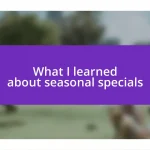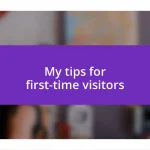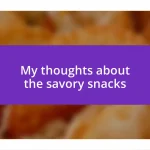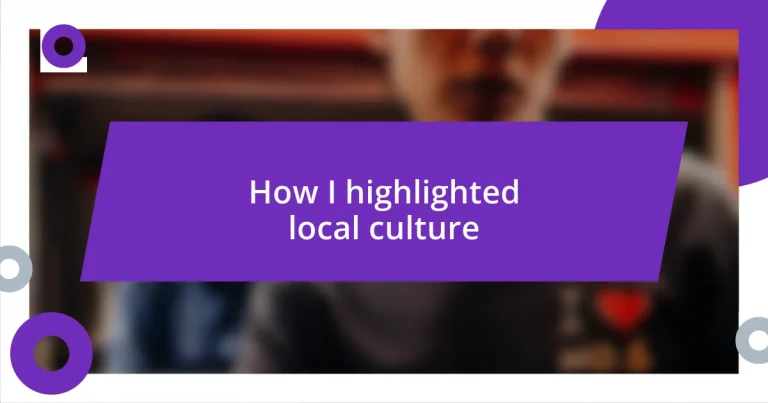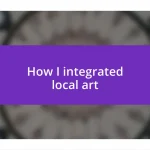Key takeaways:
- Understanding and engaging with local culture foster community identity, connection, and empathy through participation in traditions and events.
- Documenting and sharing cultural narratives through storytelling preserves heritage and promotes a sense of belonging across generations.
- Social media serves as a powerful tool to amplify local culture, reconnecting individuals and inviting wider participation in community experiences.
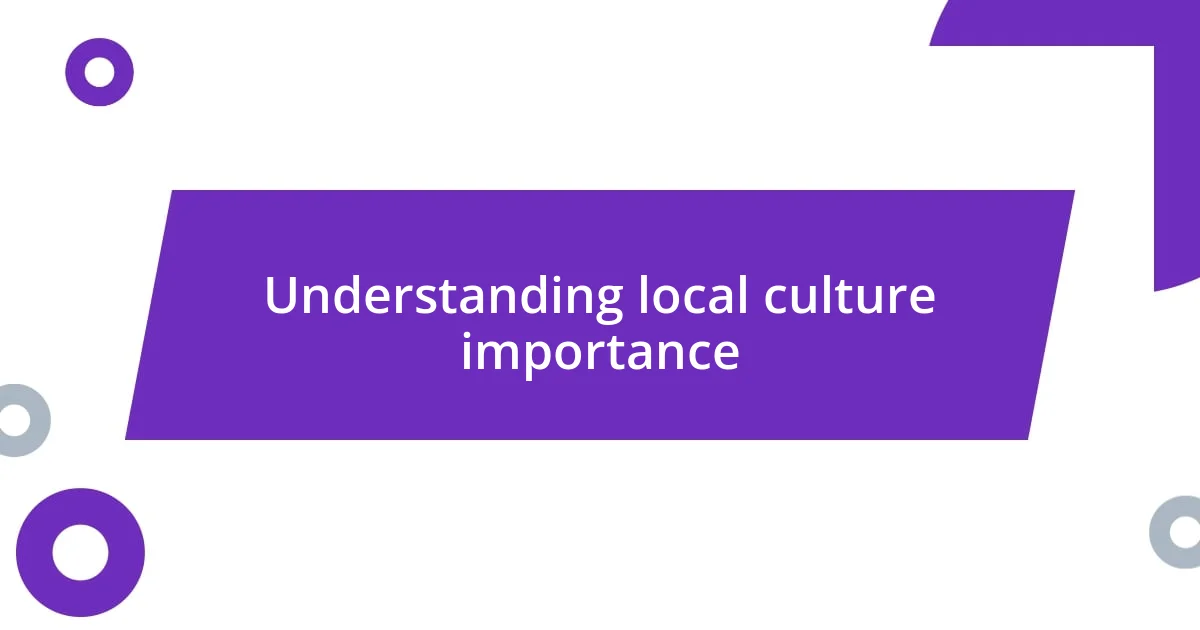
Understanding local culture importance
Understanding local culture is vital because it fosters a sense of belonging and identity within a community. I remember my first visit to a small town where I participated in a traditional festival; the warmth of the locals was palpable. Their stories, foods, and dances reflected a rich tapestry of history that made me realize how deeply intertwined culture is with our everyday lives.
When I think about local culture, I often wonder how many people overlook its value. Have you ever tried a dish unique to a specific area and felt connected to its heritage? It’s fascinating how food can bridge gaps, making us appreciate different traditions and experiences. Engaging with local culture not only enriches our understanding but also nurtures empathy and respect for diverse lifestyles.
Moreover, recognizing local culture can transform how we perceive the world around us. I once attended a cultural workshop, and it opened my eyes to the significance of rituals that may appear simple but carry profound meanings. Isn’t it amazing how some customs can encapsulate the hopes and dreams of an entire community? Embracing local culture empowers us to cherish and learn from our differences, reminding us that we are all part of a larger human narrative.
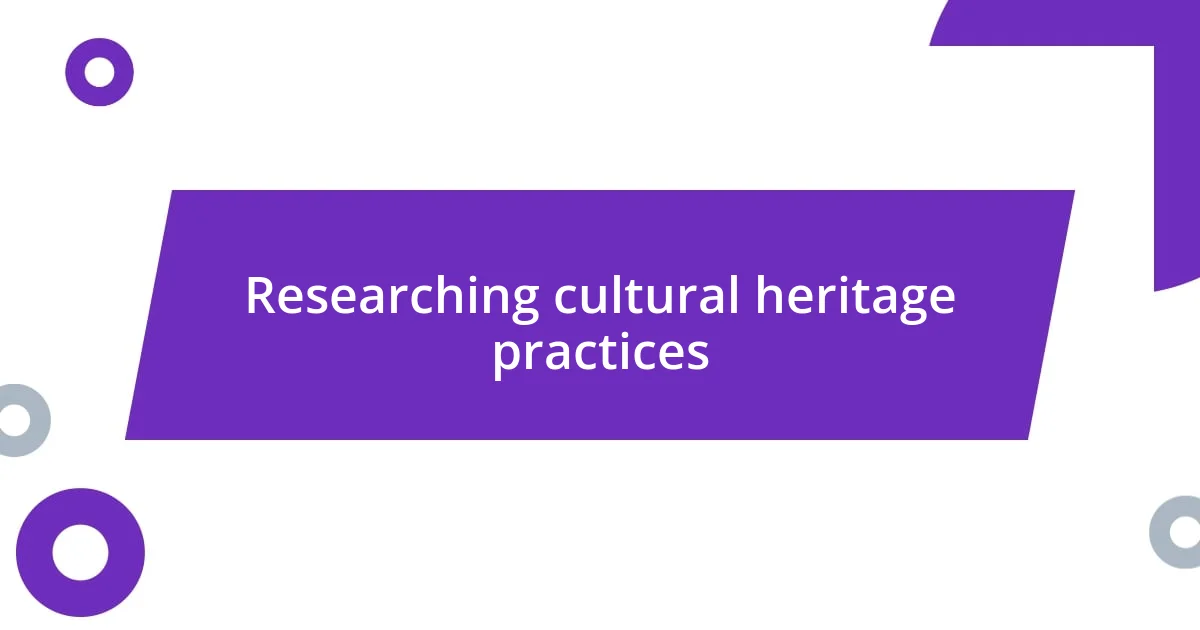
Researching cultural heritage practices
Researching cultural heritage practices requires a hands-on approach, where immersing oneself in the local environment can yield priceless insights. During my travels, I often seek out community gatherings and festivals, a direct way to witness tradition firsthand. I remember attending a local craft fair where artisans showcased their skills, each item telling a unique story tied to the area’s history and values.
Here are some key elements to consider when delving into cultural heritage practices:
- Interviews with locals: Engaging with community members provides personal perspectives and narratives that enrich your understanding.
- Participation in events: Actively taking part in cultural celebrations can deepen your connection to the local traditions.
- Exploration of historical sites: Visiting museums and historical landmarks reveals the tangible aspects of culture and heritage.
- Study of traditional arts and crafts: Understanding artisanal practices showcases the skills passed down through generations.
- Documenting oral histories: Collecting stories from elders helps preserve the community’s legacy for future generations.
Embracing these methods has allowed me to appreciate the subtle nuances of local cultures in a way that books alone cannot convey. Each interaction feels like a thread woven into the broader narrative, making the experience not just informative, but genuinely transformative.
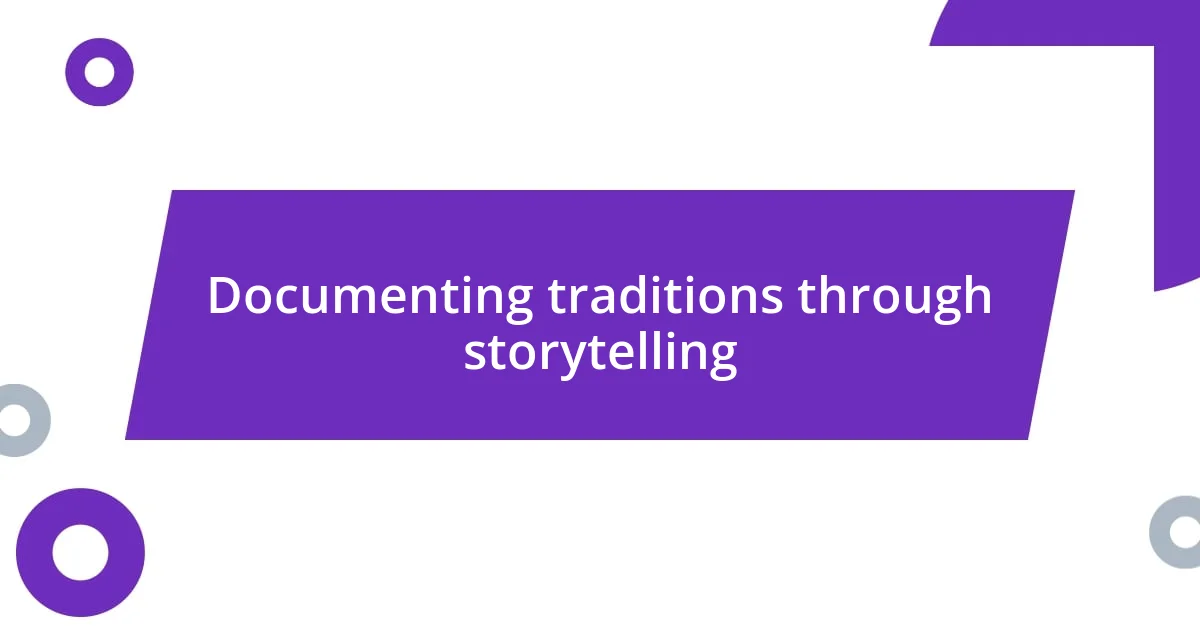
Documenting traditions through storytelling
Documenting traditions through storytelling is a powerful way to capture the essence of a culture. I remember sitting around a fire with local elders who shared tales of their ancestors. Each story was like a window into the past, showcasing their values, struggles, and triumphs. Listening to their voices, I felt the weight of history in each narrative, reminding me that storytelling is not just a form of entertainment; it’s a vital thread that connects generations.
In my experience, engaging with these narratives often evokes a sense of nostalgia and pride. For instance, during a community event, I watched as a grandmother recounted the story of her family’s migration. Her emotions were palpable, and it drew the listeners in, making them reflect on their own family histories. Aren’t we all shaped by the stories of those who came before us? These moments taught me that oral traditions are more than just tales; they are the blueprints of community identity.
Furthermore, documenting these stories allows us to share our heritage with the wider world. One day, I decided to compile the stories I had collected during my travels into a small book. The process illuminated how each narrative forged connections among people from diverse backgrounds, creating a richer tapestry of shared human experience. It became evident that when we document traditions through storytelling, we celebrate not just our differences, but also our shared humanity.
| Aspect | Significance |
|---|---|
| Connection | Storytelling fosters bonds and understanding between generations. |
| Preservation | It helps to keep traditions alive for future generations. |
| Identity | Stories reinforce community identity and shared values. |
| Emotion | Emotional storytelling engages and resonates with listeners. |
| Empathy | Hearing different experiences cultivates empathy among listeners. |
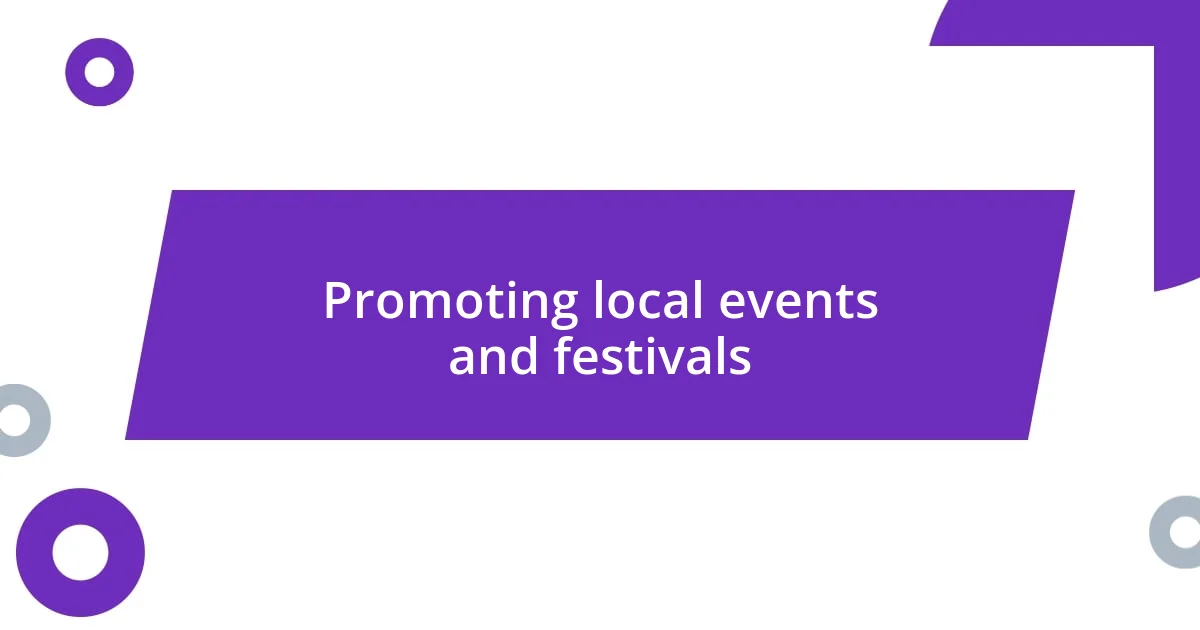
Promoting local events and festivals
Promoting local events and festivals has a way of breathing life into community culture. I remember attending a vibrant street fair in a small town where the air was filled with laughter, delicious aromas, and the sound of live music. It’s amazing how these gatherings spotlight local talent and foster a sense of belonging. Have you ever felt the energy of a festival that just pulls you in?
I often think about how strategic promotion of these events can create lasting connections. For instance, during a town’s annual cultural carnival, I noticed how social media played a pivotal role in sharing the experiences of attendees. The colorful posts and real-time stories drew more visitors than ever before. It reminded me of the power of storytelling in inviting others to be a part of something special. Isn’t it fascinating how a simple post can transform a local event into a focal point for outsiders?
Engaging with local festivals not only boosts tourism but also preserves the essence of community spirit. I once helped organize a heritage showcase where locals demonstrated traditional crafts. Seeing families come together to learn about their own culture left a profound mark on me. The joy in children’s eyes as they tried their hand at pottery or painting reminded me of how crucial it is to pass on these practices. Doesn’t that show just how vital local events are for nurturing our connections to culture?
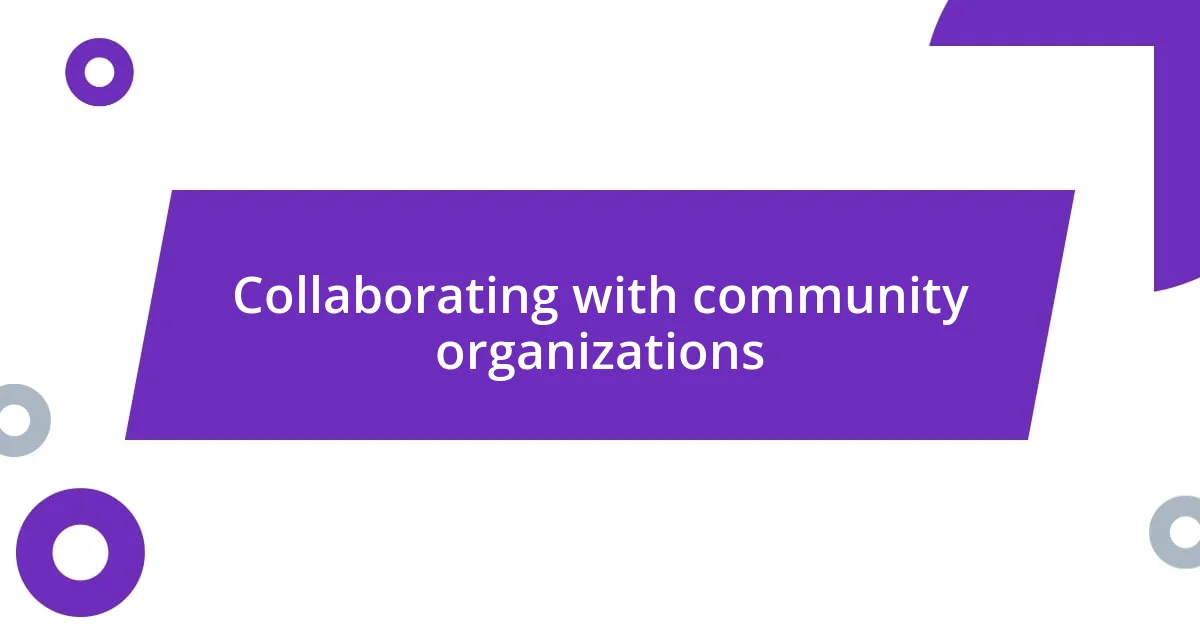
Collaborating with community organizations
Collaborating with community organizations can be a transformative experience for both the community and the individuals involved. I remember partnering with a local arts group to create a mural that reflected the history of our neighborhood. The voices of everyone involved, from the artists to the residents who contributed their stories, made the project not just a work of art, but a true reflection of collective identity.
I found that these collaborations often lead to unexpected connections. For example, while working with a community garden initiative, I met people from various backgrounds who shared their own cultural traditions related to gardening. Hearing one woman passionately explain how her grandmother had taught her to preserve herbs connected me deeply to the roots of our shared efforts. Isn’t it remarkable how working together can turn personal stories into a community tapestry?
Moreover, establishing these partnerships fosters a sense of ownership and pride among participants. I once facilitated a workshop with a local youth organization focused on traditional crafts. Watching young people transform their ideas into tangible art and create a showcase for the community was inspiring. It made me reflect—how often do we provide opportunities for the next generation to express their cultural identity? Each collaboration becomes a platform, allowing voices to rise and echo the vibrant culture we cherish.
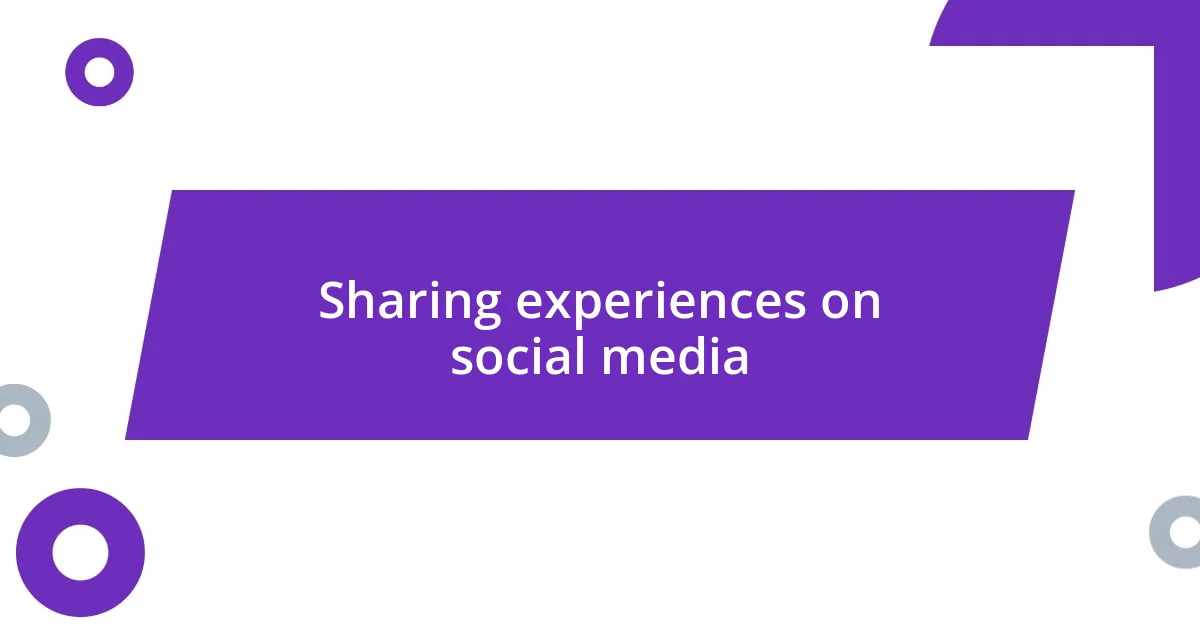
Sharing experiences on social media
Sharing experiences on social media can amplify the vibrancy of local culture in ways I never imagined. I once posted a video of a traditional dance at a community event, and to my surprise, it sparked conversations from people I hadn’t spoken to in years. The comments flooded in, with friends sharing their own memories of similar events, reminding me how powerful a single post can be in reconnecting us to our roots—have you ever felt that rush of nostalgia when you see something that connects you back to your community?
There was a time I organized a photo challenge encouraging locals to share images of our town’s hidden gems. The feedback was uplifting; photographers of all skills joined in, creating a tapestry of stories and experiences. I’ll never forget the heartwarming message I received from someone who rediscovered their love for the town through the eyes of others. It made me ponder, how often do we really see our environment through a fresh lens? It’s an exhilarating reminder that by sharing our experiences, we invite others to see the richness of culture we sometimes take for granted.
I’ve found that social media doesn’t just document experiences; it shapes them. At a neighborhood potluck, I took a moment to live-stream the diverse dishes and shared the stories behind them. The comments and shares that followed turned the gathering into a broader community celebration, well beyond that evening. Isn’t it remarkable how these digital platforms can turn local events into inclusive experiences that transcend time and space? It’s a fascinating way to unite people—inviting them into our world and, in return, allowing them to contribute their own narratives.








